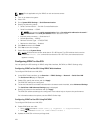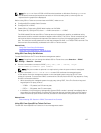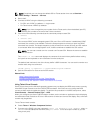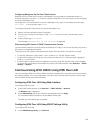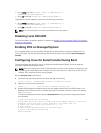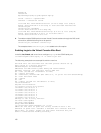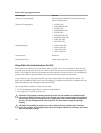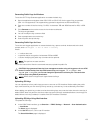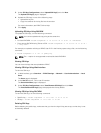
• Using config command: racadm config -g cfgRacTuning -o
cfgRacTuneRemoteRacadmEnable 1
• Using set command: racadm set iDRAC.Racadm.Enable 1
To disable the remote capability, type one of the following command:
• Using config command: racadm config -g cfgRacTuning -o
cfgRacTuneRemoteRacadmEnable 0
• Using set command: racadm set iDRAC.Racadm.Enable 0
NOTE: It is recommended to run these commands on the local system.
Disabling Local RACADM
The local RACADM is enabled by default. To disable, see Disabling Access to Modify iDRAC Configuration
Settings on Host System.
Enabling IPMI on Managed System
On a managed system, use the Dell Open Manage Server Administrator to enable or disable IPMI. For
more information, see the Dell Open Manage Server Administrator’s User Guide at dell.com/support/
manuals.
Configuring Linux for Serial Console During Boot
The following steps are specific to the Linux GRand Unified Bootloader (GRUB). Similar changes are
required if a different boot loader is used.
NOTE: When you configure the client VT100 emulation window, set the window or application that
is displaying the redirected Virtual Console to 25 rows x 80 columns to make sure the correct text
displays. Else, some text screens may be garbled.
Edit the /etc/grub.conf file as follows:
1. Locate the General Setting sections in the file and add the following:
serial --unit=1 --speed=57600 terminal --timeout=10 serial
2. Append two options to the kernel line:
kernel ............. console=ttyS1,115200n8r console=tty1
3. Disable GRUB's graphical interface and use the text-based interface. Else, the GRUB screen is not
displayed in RAC Virtual Console. To disable the graphical interface, comment-out the line starting
with splashimage.
The following example provides a sample /etc/grub.conf file that shows the changes described in
this procedure.
# grub.conf generated by anaconda
# Note that you do not have to rerun grub after making changes to this file
# NOTICE: You do not have a /boot partition. This means that all
# kernel and initrd paths are relative to /, e.g.
# root (hd0,0)
# kernel /boot/vmlinuz-version ro root=/dev/sdal
# initrd /boot/initrd-version.img
#boot=/dev/sda
131




